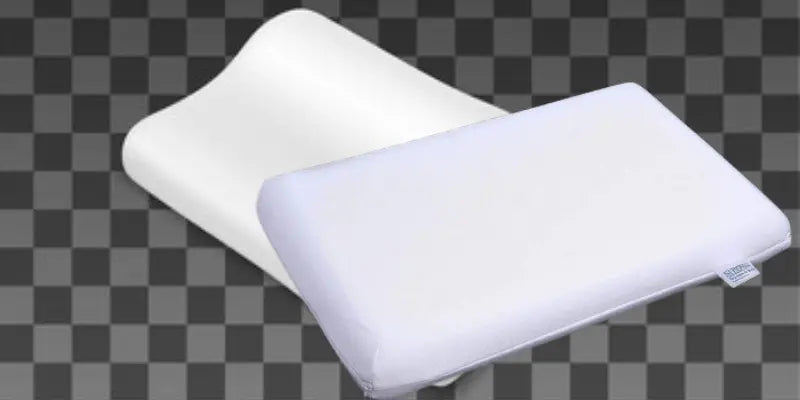
What is a Memory Foam Pillow?
Everyone wants to wake up refreshed and ready to face the day, but how often do you feel this way? Most people will have no answer. With such a lifestyle, most people struggle to get enough quality sleep at night. We look for everything that will help us get a good night's sleep; if you are one of these people, look no further.
What is a Memory Foam Pillow?
Introducing you to a memory foam pillow. It's not like the traditional pillows in our house, but rather an upgraded version. This blog will teach you everything you need to know about memory foam pillows and how they can help you sleep better at night.
A memory foam pillow is a type of pillow made from a special material called memory foam. This foam was originally developed by NASA to improve seat cushioning and crash protection for astronauts. Today, it’s used in pillows and mattresses to help people sleep better.
Key Features of Memory Foam Pillows
1. Soft and Supportive: Memory foam is known for its softness and ability to support your head and neck. It molds to the shape of your body, giving you personalized comfort. Memory foam supports your neck properly. In fact, it cradles your neck and makes sure that the joints don’t experience any kind of pressure. And it does this because of its unique ability to mold.
As soon as you rest your head and neck on the cooling pillow, memory foam uses the pressure and the heat from your body to change its shape and form a support structure around your neck. If you want to prevent neck pain and stiffness, then go for a memory foam pillow.
2. Pressure Relief: The foam responds to the heat and weight of your body, which helps to relieve pressure points. This means if you often wake up with neck or shoulder pain, a memory foam pillow might help.
Memory foam helps in maintaining spinal alignment by succumbing to the pressure applied by your head and neck. Our spine has a natural curvature. If this curvature isn’t maintained, the joints and disks in the spine experience severe wear and tear. Apart from posture issues, this can happen because of the wrong pillow type or size.
3. Durability: Memory foam is quite durable and can maintain its shape for a long time. It doesn’t go flat quickly like some other types of pillows. You no longer have to replace your pillow every year. Instead, you can rely on a memory foam pillow for at least 5 years.
As a very dense material, memory foam prevents the buildup of dust and dust mites. Further, it isn’t a biodegradable material. Another common problem with traditional pillows made with materials such as down, cotton, and feather is that they flatten out over time because of repeated use. Memory foam, on the other hand, retains its original shape all through its life span, preventing the pillow from flattening out overtime.
4. Hypoallergenic: Many memory foam pillows are made to be resistant to dust mites and other allergens, which is great for people with allergies. Dust and dust mites can cause serious allergies in people with sensitive skin. Most pillows fill abet dust and dust mite buildup, causing allergies.
But this isn’t the case with memory foam, which is naturally hypoallergenic. And because of its dense nature, it prevents buildup of dust and dust mites. To further enhance the hypoallergenic property of memory foam, you should purchase a hypoallergenic pillow protector made with materials such as bamboo derived rayon fabric.
5. Temperature Sensitivity: Some memory foam pillows are designed to stay cool or have cooling gel layers to help regulate temperature. Solid memory foam pillows retain body heat and disable the hot air from escaping.
However, this isn’t the case with a shredded memory foam pillow, which has better inner ventilation because of the shredded nature of the foam. The memory foam still retains body heat to mold, but the hot air escapes the pillow easily, providing a cool and comforting experience all through the night.
How Does it Impact Sleep Quality?
- Better Alignment: Memory foam pillows help keep your head, neck, and spine aligned while you sleep. Proper alignment can reduce the risk of waking up with aches and pains.
- Reduced Tossing and Turning: Because memory foam molds to your body, it can help you stay comfortable throughout the night, which may lead to fewer interruptions in your sleep.
- Customized Comfort: The foam adjusts to your best sleeping position, whether you’re a side sleeper, back sleeper, or stomach sleeper. This personalized fit can contribute to a more restful sleep.
- Less Disruption: Memory foam pillows tend to absorb motion better than traditional pillows. This means if you share your bed with a partner, you might be less likely to be disturbed by their movements.
Which Pillow Cover to Choose for Memory Foam Pillows?
The cover of the pillow can affect its breathability and comfort. Look for a cover made of breathable fabric or one with cooling properties if you tend to get hot at night.
Since memory foam pillows are naturally hypoallergenic, it makes sense to select a cover made of hypoallergenic material as well. But you also need something that doesn’t irritate your skin or damage your hair. And since memory foam retains body heat, you want the cover to be as breathable as possible.
So many criteria yet so few materials. But one fits the bill perfectly - bamboo pillow protector. Bamboo rayon fabric is naturally hypoallergenic and as soft as skin. So it doesn’t irritate your skin, damage your hair, or cause allergies.
Here are the benefits of a pillow cover made with bamboo rayon fabric:
Silky Smooth Surface
A silky smooth surface minimizes the friction caused by the fabric. With minimum friction against your skin and hair, you get to enjoy a great beauty sleep. And it's just not the smoothness of silk that bamboo covers emulate but also its shine that embellishes your bedroom.
Moisture Free
While synthetic fibers don’t absorb moisture, cotton irritates the skin.Bamboo fabric, however, absorbs moisture yet doesn’t irritate the skin. So you get the best of both worlds. Moisture absorption is important, as it prevents your pillow from becoming a petri dish for acne causing bacteria.
Environment Friendly
Climate change is a huge problem, so we all need to do our part. The minimum we can do is use biodegradable material, which doesn’t build up in the environment. Bamboo rayon fabric is one such material that biodegrades naturally. And since it is derived from bamboo, it doesn’t consume a lot of water.
Conclusion
A memory foam pillow can be a great addition to your sleep routine. When choosing a memory foam pillow, consider factors like firmness, shape, cover material, and budget to find the one that’s best for you. With the right pillow, you can enjoy more restful and rejuvenating sleep.
If you are looking out for a memory foam pillow for yourself, Sleepsia memory foam pillow could be the best option for you as it is affordable and made up of 100% memory foam. Its ability to mold to your body, provide pressure relief, and help with alignment can lead to better sleep quality and less discomfort.
FAQs
Q. Are Memory Foam Pillows Washable?Ans. Although you can wash the pillow case and cover, don’t throw in the memory foam into your washing machine, as the material automatically disintegrates upon washing. However, you can spot clean the memory foam.
Q. Do These Pillows Contain Odor?Ans. The odor of memory foam generally disappears in a day or two. However, the odor does let you know that the pillow has never been used before.
Q. Is Latex Better Than Memory Foam?Ans. No. Latex pillows, though malleable, don’t last as long as memory foam. Further, they don’t prevent the build up of dust mites and dust.
Q. Can People with Skin Allergies Use This Pillow?Ans. Both memory foam and bamboo fabric are hypoallergenic, so they rarely cause any skin allergies. And selecting the right pillow cover ensures that your skin doesn’t experience irritation.
Q. Are Cooling Gel Pillows Hypoallergenic?Ans. Yes, they’re hypoallergenic. Further, they keep your skin cool and prevent the buildup of moisture.








